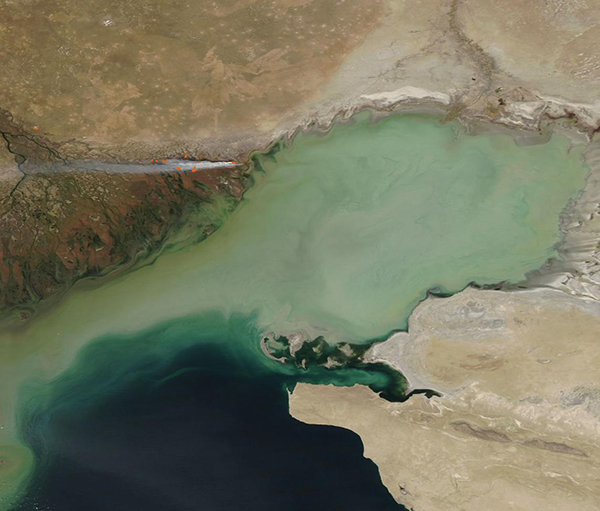Images
October 12, 2021 - Sediment in the Caspian Sea
Tweet
The waters of the north-eastern Caspian Sea were stained a milky green as fires burned along the edge of the Volga Delta in early October 2021. The Moderate Resolution Imaging Spectroradiometer (MODIS) on board NASA’s Aqua satellite acquired this true-color image of the scene on October 8.
The Caspian Sea is the world’s largest landlocked body of water. Stretching 1,200 kilometers (750 miles) from north to south, it intersects five countries in Asia and Europe, with Kazakhstan wrapped around the shallow waters of the northeastern corner of the lake. It is here that the massive Volga River and the smaller Ural River pour freshwater into the Caspian Sea, along with heavy sediment. The inflow of both of these rivers also creates currents that can lift sediment from the muddy bottom and carry it in swirls along with the currents. Sediment appears tan when it floats near the top of the water, but as it sinks and disperses into deeper and clearer water, the color changes to a range of light blues, turquoises, and greens.
Several red “hot spots” sit along the edge of the greening that marks the Volga Delta. These mark areas where the thermal bands on the MODIS instrument detected high temperatures. When combined with typical smoke—as in this image—such hot spots mark actively burning fire. The large, light gray smoke plume stretches nearly due west, driven by strong winds. While it’s not possible to determine the cause of a fire from a satellite image, give the time of year, the location of the fires, and that there are several of them, these fires are most likely to be either agricultural in nature or prescribed burns used to manage land.
Image Facts
Satellite:
Aqua
Date Acquired: 10/8/2021
Resolutions:
1km (171.9 KB), 500m (91.1 KB), 250m (284.8 KB)
Bands Used: 1,4,3
Image Credit:
MODIS Land Rapid Response Team, NASA GSFC
Tweet
The waters of the north-eastern Caspian Sea were stained a milky green as fires burned along the edge of the Volga Delta in early October 2021. The Moderate Resolution Imaging Spectroradiometer (MODIS) on board NASA’s Aqua satellite acquired this true-color image of the scene on October 8.
The Caspian Sea is the world’s largest landlocked body of water. Stretching 1,200 kilometers (750 miles) from north to south, it intersects five countries in Asia and Europe, with Kazakhstan wrapped around the shallow waters of the northeastern corner of the lake. It is here that the massive Volga River and the smaller Ural River pour freshwater into the Caspian Sea, along with heavy sediment. The inflow of both of these rivers also creates currents that can lift sediment from the muddy bottom and carry it in swirls along with the currents. Sediment appears tan when it floats near the top of the water, but as it sinks and disperses into deeper and clearer water, the color changes to a range of light blues, turquoises, and greens.
Several red “hot spots” sit along the edge of the greening that marks the Volga Delta. These mark areas where the thermal bands on the MODIS instrument detected high temperatures. When combined with typical smoke—as in this image—such hot spots mark actively burning fire. The large, light gray smoke plume stretches nearly due west, driven by strong winds. While it’s not possible to determine the cause of a fire from a satellite image, give the time of year, the location of the fires, and that there are several of them, these fires are most likely to be either agricultural in nature or prescribed burns used to manage land.
Image Facts
Satellite:
Aqua
Date Acquired: 10/8/2021
Resolutions:
1km (171.9 KB), 500m (91.1 KB), 250m (284.8 KB)
Bands Used: 1,4,3
Image Credit:
MODIS Land Rapid Response Team, NASA GSFC




